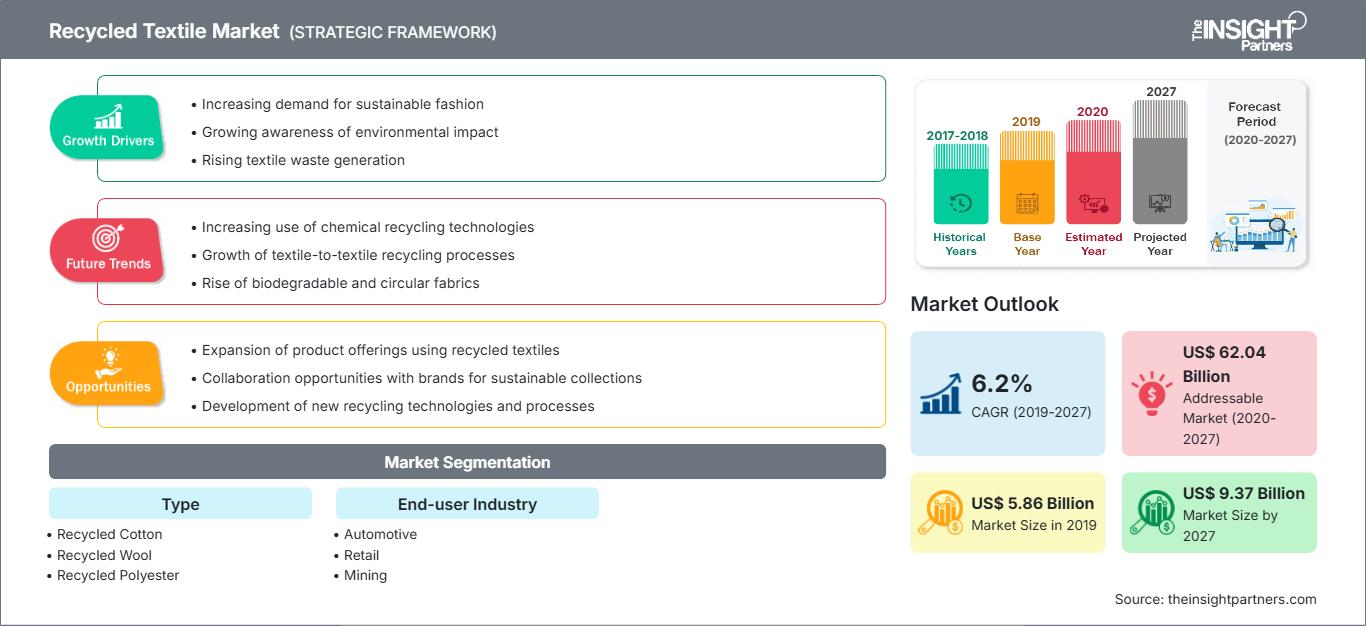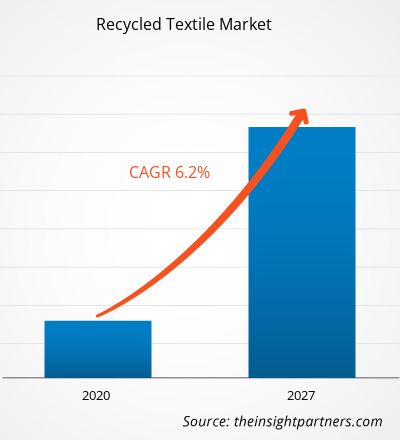Il mercato dei tessuti riciclati è stato valutato a 5.855,39 milioni di dollari nel 2019 e si prevede che raggiungerà i 9.365,04 milioni di dollari entro il 2027; si prevede una crescita a un CAGR del 6,2% dal 2020 al 2027.
I tessuti riciclati sono vecchi indumenti o altri tessuti inutilizzati che possono essere recuperati per il riutilizzo o il recupero di materiali. Negli ultimi anni, sono aumentate le preoccupazioni relative allo smaltimento dei rifiuti tessili in tutto il mondo, che potrebbe avere un impatto negativo sull'ambiente. La domanda di tessuti riciclati è in aumento in tutto il mondo, con un'impennata della domanda da parte di diversi settori di utilizzo finale, tra cui abbigliamento, tessuti, automotive e altri. I produttori riciclano i tessuti usati in prodotti migliori, che potrebbero essere utilizzati in diversi settori di utilizzo finale, adottando diverse tecnologie. Il riciclaggio delle risorse può essere effettuato principalmente con l'ausilio di tecniche termiche, meccaniche e chimiche.
L'Europa è diventata un mercato significativo per i tessuti riciclati grazie alle crescenti iniziative governative nella regione. Inoltre, la crescente domanda di prodotti tessili riciclati nell'industria automobilistica offre un'opportunità redditizia per gli operatori del mercato tessile riciclato che operano sul mercato. L'aumento del potere d'acquisto, unito al cambiamento dello stile di vita, è uno dei principali fattori trainanti della crescita del mercato tessile in Europa. In Europa, quasi il 15% degli indumenti usati dai consumatori viene riciclato, mentre oltre il 75% degli indumenti pre-uso viene riciclato dai produttori per usi industriali. La domanda di tessuti riciclati in Europa sta crescendo a un ritmo sostenuto negli ultimi anni. I produttori di tessuti riciclati si stanno concentrando su paesi come Germania, Regno Unito, ecc., il che ha portato a un'enorme domanda di tessuti riciclati in Europa. Si prevede inoltre che la crescente attenzione dei consumatori verso un'economia tessile circolare stimolerà ulteriormente la crescita del mercato nella regione.
Stati Uniti, Brasile, India, Russia, Sudafrica, Messico, Spagna e Regno Unito sono tra i paesi più colpiti in termini di casi confermati e decessi segnalati ad agosto 2020. Il COVID-19 ha colpito le economie e le industrie di diversi paesi a causa di lockdown, divieti di viaggio e chiusure aziendali. L'industria chimica e dei materiali a livello globale è uno dei settori che ha subito gravi interruzioni, come interruzioni della catena di approvvigionamento e interruzioni nella produzione a causa dell'epidemia di COVID-19. Ad esempio, la Cina è il polo manifatturiero globale e il principale fornitore di materie prime per diversi settori. Il blocco di vari stabilimenti e fabbriche in Cina e in regioni chiave come l'Asia-Pacifico e l'Europa sta influenzando le catene di approvvigionamento globali e incidendo negativamente sulla produzione, sui tempi di consegna e sulle vendite di vari beni. Tutti questi fattori hanno avuto un impatto significativo sul mercato globale del tessile riciclato.
Personalizza questo rapporto in base alle tue esigenze
Potrai personalizzare gratuitamente qualsiasi rapporto, comprese parti di questo rapporto, o analisi a livello di paese, pacchetto dati Excel, oltre a usufruire di grandi offerte e sconti per start-up e università
Mercato dei tessuti riciclati: Approfondimenti strategici

-
Ottieni le principali tendenze chiave del mercato di questo rapporto.Questo campione GRATUITO includerà l'analisi dei dati, che vanno dalle tendenze di mercato alle stime e alle previsioni.
Il processo di produzione tessile è considerato uno dei processi ad alta intensità chimica che genera un elevato volume di rifiuti tessili durante le sue operazioni. I rifiuti tessili possono essere suddivisi in due gruppi: rifiuti tessili pre-consumo e rifiuti tessili post-consumo. L'aumento della quantità di rifiuti tessili crea un impatto sull'ambiente e genera il problema di un efficace smaltimento o incenerimento nelle discariche esistenti. Secondo una stima, circa il 10-20% di tutti i prodotti tessili inutilizzati è considerato uno spreco. Ad esempio, secondo l'EPA statunitense, nel 2015 sono stati generati 15,75 milioni di tonnellate di prodotti tessili come rifiuti solidi urbani, di cui il 19% è stato incenerito, mentre il 65% è finito in discarica. Inoltre, un rapporto dell'Agenzia per la protezione ambientale statunitense suggerisce che la produzione e lo smaltimento dei prodotti tessili comportano emissioni di gas serra. Inoltre, il processo di incenerimento emette sostanze organiche come metalli pesanti, diossine, gas acidi e particelle di polvere, considerate dannose sia per l'uomo che per l'ambiente. Anche lo smaltimento delle ceneri residue è diventato un problema serio, poiché contengono un'elevata concentrazione di materiali tossici. Pertanto, è assolutamente fondamentale gestire efficacemente i rifiuti tessili attraverso metodi di riutilizzo o riciclaggio, che potrebbero promuovere la sostenibilità ambientale. In tali situazioni, il riciclaggio dei rifiuti tessili è considerato un'alternativa praticabile, che contribuisce a ridurre l'impatto sulle risorse naturali, riduce al minimo la necessità di spazio in discarica e contribuisce al risparmio energetico. Inoltre, le severe normative governative che regolano la gestione efficace dei rifiuti tessili mirano potenzialmente a promuovere l'uso del riciclaggio tessile come alternativa sostenibile per affrontare l'imminente problema dei rifiuti.
Approfondimenti sulla tipologia
In base alla tipologia, il mercato del tessile riciclato è segmentato in cotone riciclato, lana riciclata, poliestere riciclato, nylon riciclato e altri. Si prevede che il segmento del nylon riciclato crescerà al tasso più rapido nel periodo di previsione 2019-2027. Il nylon riciclato è prodotto da plastiche industriali, fibre di scarto, scarti di tessiture e reti da pesca post-consumo. Questi vengono rigenerati in nuovo nylon, che ha la stessa qualità del nylon vergine. Anche borse, tessuti e tappeti in nylon vengono convertiti in nylon riciclato per un ulteriore utilizzo. Gran parte del nylon riciclato proviene dalle reti da pesca. Rappresenta un'ottima soluzione per riciclare i rifiuti oceanici. Il riciclaggio del nylon è un processo costoso rispetto al nylon, ma offre numerosi vantaggi ambientali. Riciclando il nylon, è possibile eliminare gli scarti e ridurre le emissioni di gas serra derivanti dalla produzione. Si riduce la dipendenza dal petrolio come fonte di materie prime. L'utilizzo di nylon riciclato contribuisce anche a promuovere nuovi flussi di riciclo per i prodotti in nylon non più in uso. La maggior parte dei materiali riciclati meccanicamente viene fusa ad alte temperature, che finiscono per distruggere i contaminanti e trasformare i materiali in forme riutilizzabili. Il nylon fonde a basse temperature durante il riciclo, rilasciando contaminanti. Pertanto, il nylon deve essere accuratamente pulito prima del riciclo.
Approfondimenti sul settore degli utenti finali
In base al settore degli utenti finali, il mercato del riciclo è segmentato in automotive, commercio al dettaglio, minerario e altri. Si prevede che il segmento automotive crescerà al tasso di crescita più rapido nel periodo di previsione 2019-2027. I tessuti riciclati vengono utilizzati nell'industria automobilistica e contribuiscono in modo significativo alla produzione di componenti per automobili. L'uso di tessuti riciclati nelle applicazioni automobilistiche include componenti visibili come rivestimenti per pavimenti, rivestimenti, cinture di sicurezza e tessuti riciclati non visibili agli occhi dell'osservatore come tubi e nastri, cordoni per pneumatici, componenti di airbag e fibre. I tessuti riciclati sono utilizzati nell'industria automobilistica per la loro resistenza alla trazione, all'abrasione, alla permeabilità all'aria, alla compressione, all'elasticità, alla facilità di pulizia, alla resistenza alla fiamma e alle condizioni climatiche dinamiche. Il cotone riciclato viene utilizzato per l'imbottitura dei sedili o per l'isolamento delle automobili.
Anandi Enterprises, Chindi, Khaloom Textile India Pvt. Ltd., Kishco Group, tra gli altri, sono i principali attori presenti nel mercato globale del tessile riciclato. Queste aziende stanno implementando strategie di sviluppo di nuovi prodotti e fusioni e acquisizioni per ampliare la base clienti e acquisire quote di mercato significative in tutto il mondo, il che, a sua volta, consente loro di mantenere il proprio marchio a livello globale.
Mercato del tessile riciclato
Mercato del tessile riciclatoLe tendenze regionali e i fattori che influenzano il mercato dei tessuti riciclati durante il periodo di previsione sono stati ampiamente spiegati dagli analisti di The Insight Partners. Questa sezione analizza anche i segmenti e la geografia del mercato dei tessuti riciclati in Nord America, Europa, Asia-Pacifico, Medio Oriente e Africa, America Meridionale e Centrale.
Ambito del rapporto sul mercato dei tessuti riciclati
| Attributo del rapporto | Dettagli |
|---|---|
| Dimensioni del mercato in 2019 | US$ 5.86 Billion |
| Dimensioni del mercato per 2027 | US$ 9.37 Billion |
| CAGR globale (2019 - 2027) | 6.2% |
| Dati storici | 2017-2018 |
| Periodo di previsione | 2020-2027 |
| Segmenti coperti |
By Tipo
|
| Regioni e paesi coperti |
Nord America
|
| Leader di mercato e profili aziendali chiave |
|
Densità degli operatori del mercato tessile riciclato: comprendere il suo impatto sulle dinamiche aziendali
Il mercato dei tessuti riciclati è in rapida crescita, trainato dalla crescente domanda da parte degli utenti finali, dovuta a fattori quali l'evoluzione delle preferenze dei consumatori, i progressi tecnologici e una maggiore consapevolezza dei vantaggi del prodotto. Con l'aumento della domanda, le aziende stanno ampliando la propria offerta, innovando per soddisfare le esigenze dei consumatori e sfruttando le tendenze emergenti, alimentando ulteriormente la crescita del mercato.

- Ottieni il Mercato dei tessuti riciclati Panoramica dei principali attori chiave
- Le tendenze progressive del settore nel mercato globale dei tessili riciclati aiutano gli operatori a sviluppare strategie efficaci a lungo termine
- Strategie di crescita aziendale adottate dai mercati sviluppati e in via di sviluppo
- Analisi quantitativa del mercato globale dei tessili riciclati dal 2017 al 2027
- Stima della domanda globale di tessili riciclati in vari settori
- Analisi PEST per illustrare l'efficacia di acquirenti e fornitori che operano nel settore nel prevedere la crescita del mercato
- Sviluppi recenti per comprendere lo scenario competitivo del mercato e la domanda globale di tessili riciclati
- Tendenze e prospettive di mercato insieme ai fattori che guidano e frenano la crescita del mercato globale dei tessili riciclati
- Processo decisionale attraverso la comprensione delle strategie che sostengono l'interesse commerciale per quanto riguarda la crescita del mercato globale dei tessili riciclati
- Dimensioni del mercato globale dei tessili riciclati in vari nodi del mercato.
- Panoramica dettagliata e segmentazione del mercato globale dei tessili riciclati, nonché le sue dinamiche nel settore
- Riciclato globale Dimensioni del mercato tessile in varie regioni con promettenti opportunità di crescita
Mercato globale dei tessuti riciclati, per tipo
- Cotone riciclato
- Lana riciclata
- Poliestere riciclato
- Nylon riciclato
- Altri
Mercato globale dei tessuti riciclati, per settore di utilizzo finale
- Automotive
- Vendita al dettaglio
- Estrazione mineraria
- Altri
Profili aziendali
- Anandi Enterprises
- Chindi
- Khaloom Textile India Pvt. Ltd.
- Kishco Group
- Usha Yarns Limited
- Hyosung Corporation
- Leigh Fibers Inc.
- Martex Fiber Southern Corporation
- Renewcell AB
- Boer Group
- Analisi storica (2 anni), anno base, previsione (7 anni) con CAGR
- Analisi PEST e SWOT
- Valore/volume delle dimensioni del mercato - Globale, Regionale, Nazionale
- Industria e panorama competitivo
- Set di dati Excel
Report recenti
Testimonianze
Motivo dell'acquisto
- Processo decisionale informato
- Comprensione delle dinamiche di mercato
- Analisi competitiva
- Analisi dei clienti
- Previsioni di mercato
- Mitigazione del rischio
- Pianificazione strategica
- Giustificazione degli investimenti
- Identificazione dei mercati emergenti
- Miglioramento delle strategie di marketing
- Aumento dell'efficienza operativa
- Allineamento alle tendenze normative






















 Ottieni un campione gratuito per - Mercato dei tessuti riciclati
Ottieni un campione gratuito per - Mercato dei tessuti riciclati